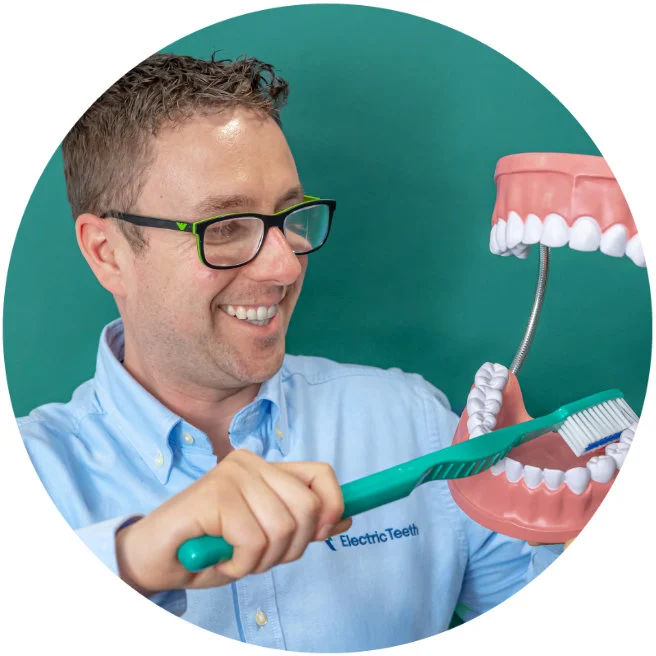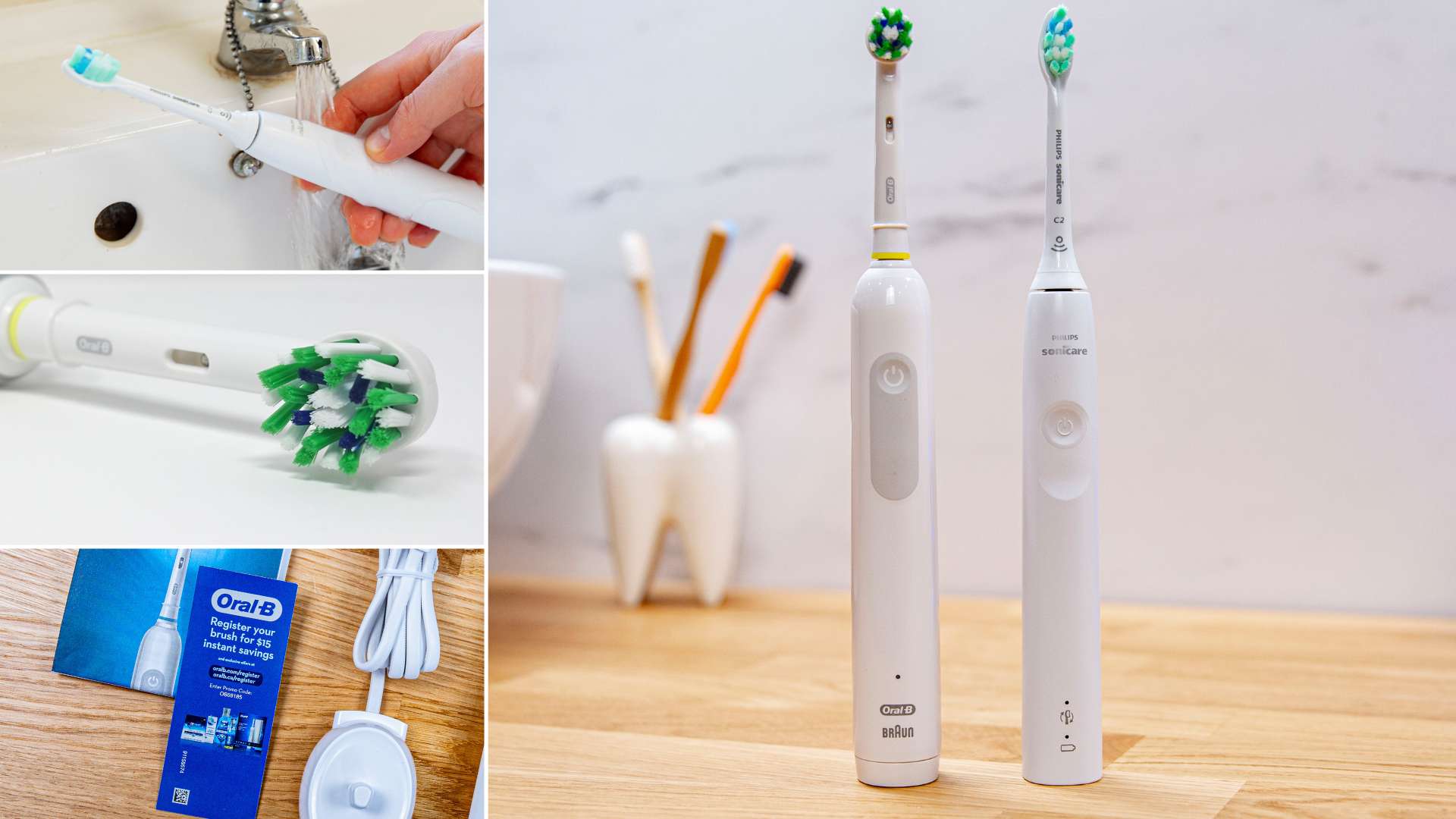
Our choice: Sonicare 4100 Series
There is a lot to like about both brushes and both clean the teeth well, but the Sonicare 4100 Series is my pick.
This is because it has a better pressure sensor implementation, 2 brushing intensities, and a longer battery life.

Key differences
| Find out more |
| Electric Teeth Rating |
| Retail price |
| Approximate 3 year cost |
| Cleaning Action |
| Number of cleaning modes |
| Brushing intensities |
| Timer |
| Pacer |
| Pressure Sensor |
| Battery life |
| Battery type |
| Number of heads included |
| Travel case included |
| Bluetooth connectivity |
| Position tracking |
| Noise |
| Warranty |
| Buying options |
|
Our Choice

|

|
|---|---|
| Review | Review |
|
(4.9)
|
(4.5)
|
| $50 | $50 |
| $150 | $105 |
| Sonic | Oscillating-rotating & pulsating (3D) |
| 1 | 3 |
| 2 | - |
|
|
|
| 30 second quadpacer | 30 second quadpacer |
|
|
|
| 14 days | 10 days |
| Rechargeable Lithium-Ion (Li-Ion) | Rechargeable Nickel Metal Hydride (NiMH) |
| 1 | 1 |
| - | - |
| - | - |
| - | - |
| 60dB | 73dB |
| 2 years | 2 years |
- Cleaning/brushing action
- The Oral-B 1000 has a 3D, oscillating, rotating and pulsating cleaning action.
- The Sonicare 4100 has a sonic cleaning action.
- Handle design/colors
- Slight differences in the handle shape and design.
- The 1000 has a small rubber gripped panel around the power button which the 4100 does not have.
- The Pro 1000 has a dimpled texture to the back of the handle compared to the smooth surface of the 4100 from Sonicare.
- The Pro 1000 is available in 4 colors (white, black, green & pink) compared with the 6 (sugar rose, white, black, deep pink, azure blue & dark forest) of the 4100 Series.
- Cleaning modes
- The Sonicare 4100 Series has just 1 cleaning mode with 2 different brushing intensities (high and low) compared to the 3 cleaning modes (daily clean, sensitive & whitening) of the Pro 1000.
- Brush heads
- The brush head size and shape are different.
- The 1000 comes with 1 x CrossAction brush head whereas the 4100 Series comes with 1 x C2 Optimal Plaque Control brush head.
- Pressure sensor
- Although both have sensors, the 4100 vibrates the handle when activated. This is something the 1000 does not do.
- Battery
- The 4100 Series uses a Lithium-Ion (li-Ion) battery compared to the Nickel Metal Hydride (NiMH) of the Oral-B 1000.
- The 4100 Series lasts 17 days vs the 10 of the 1000.
- The 4100 provides more battery charge level feedback than the 1000.
- Other features & technologies
- The 4100 has a brush head replacement reminder system which is part of the Sonicare BrushSync technology.
- Accessories & box contents
- The Sonicare charging stand supports 100-240v compared to the 110-130v of the Oral-B stand.
- The 4100 has a USB connector on the charging cable vs the 2 pin adapter of the Pro 1000.
- Other
- The Sonicare 4100 is quieter than the 1000.
- The 4100 turns off automatically at the end of the cleaning cycle.
- The 4100 has an ‘EasyStart’ feature.
- Price
- The 1000 is the cheaper brush to own over the years.
Please note. Every effort is made to ensure the key differences listed are correct, but these differences are subject to change without notice. Products and the box contents can be changed without notice and different variants can exist.
Detailed comparison: what’s the difference between the Philips Sonicare 4100 Series and Oral-B Pro 1000?
From looking at the differences between these 2 brushes, as documented in the bullet point list above, it certainly seems that the 4100 Series is the better brush. And yes, ultimately it is my pick. But, that doesn’t mean the Pro 1000 from Oral-B should be written off entirely. It is still a good toothbrush.
Allow me to explain these key differences in a little more detail.
The most noticeable difference between these models is the way in which they work to clean the teeth. Both have differing cleaning actions.
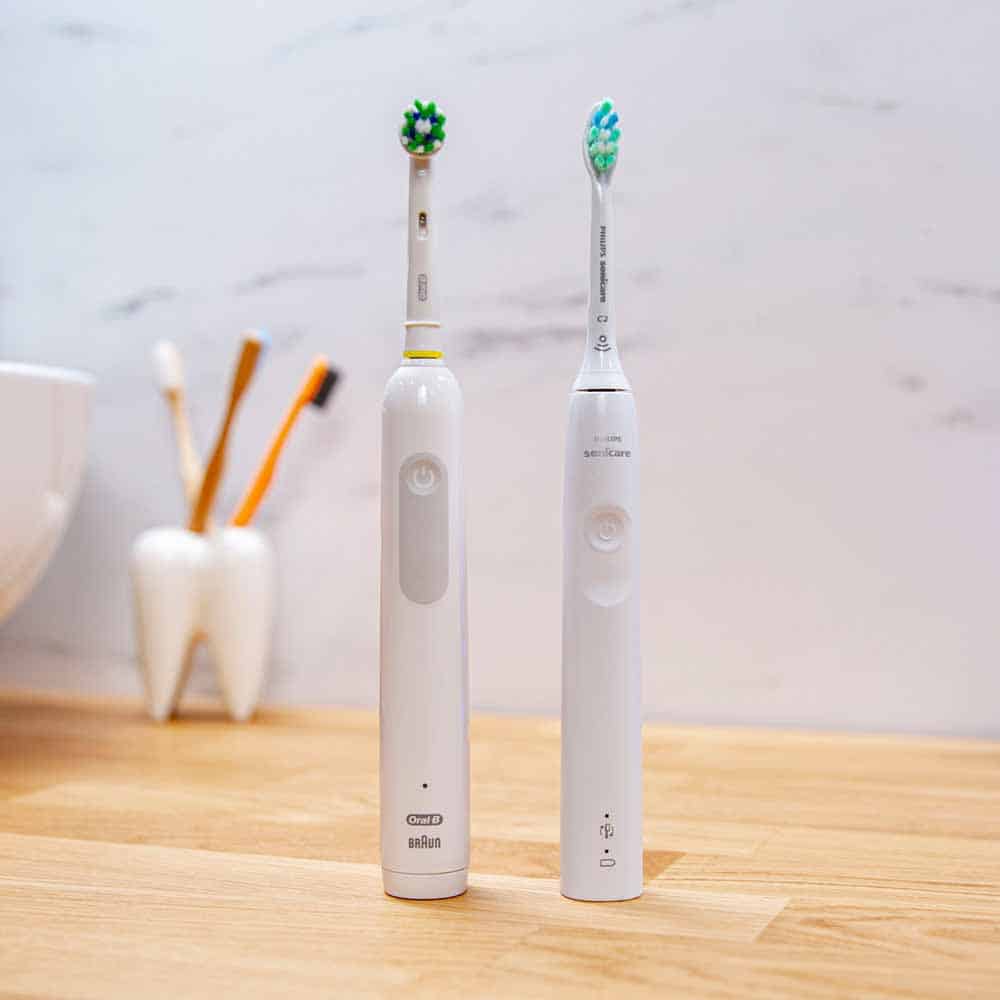
The Sonicare offers a sonic cleaning, which means the bristles move from side to side in a sweeping motion.
Compare this to the oscillating, rotating and pulsating action of the Oral-B. The bristles move from side to side, but the circular shape of the brush head means the cleaning action is rounded. The pulsations are an extra dimension to the brushing process which are essentially vibrations to assist in the cleaning.
This animated gif shows how the sonic and oscillating-rotating motions differ.
Both have been subjected to many clinical trials with conclusions that favor each type of cleaning action.
A review of the available clinical data does suggest that Oral-B takes the edge, as we explain in our Oral-B vs Sonicare article.
So, if this comparison was based on clinical evidence alone there is reason to favor the Pro 1000.
But, the researchers did conclude more study is needed, so it isn’t an outright win for the 3D cleaning action as it stands.
In most instances, your dental professional is going to be pleased if you are using either.
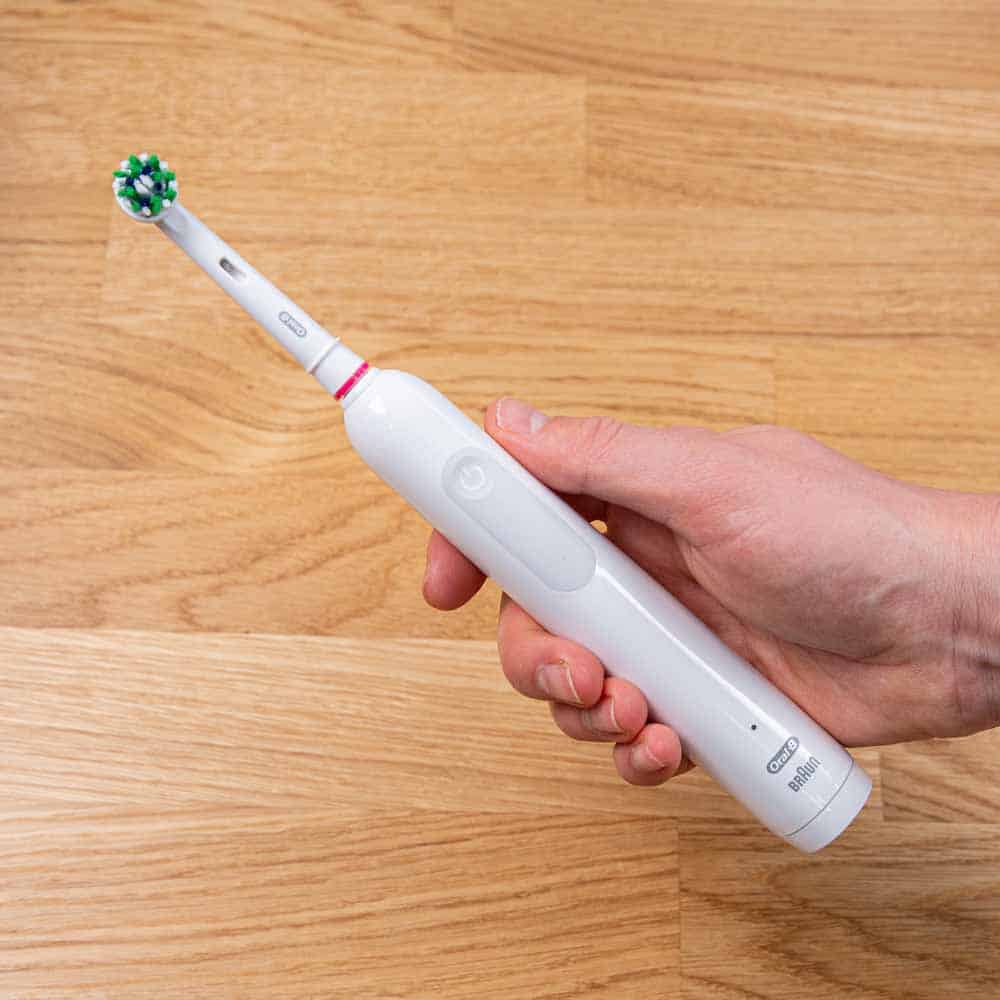
The different cleaning action does impact the brush heads supplied for each brush. Supplied in the box with both brushes is a single head.
The Pro 1000 comes with a small round CrossAction head. This is the most commonly included head with an Oral-B toothbrush. It has bristles angled at 16 degrees in a criss-cross pattern that helps give a deep and invigorating clean.
With the 4100 Series, you get a C2 Optimal Plaque Control brush head. Packed into tight clusters the bristles stand upright and are mostly the same length. It is larger with more of an ovalish shape compared to the round Oral-B.
The small round brush head is in my opinion easier to maneuver around the mouth, particularly in the tighter spaces at the back. It feels to me at least that brushing my wisdom teeth properly is a touch less awkward with the Oral-B head.
The difference in size means that an Oral-B head can usually clean a single tooth surface at a time, whereas the larger Sonicare brush head tends to cover 2 teeth at the same time.
In my experience, you get used to either, but some may have a preference, particularly if you have used one brand before. There is a familiarity that can really help if you are transitioning from other models
Each of these heads is just 1 from a range of interchangeable options available from either company. The supplied bristles are amongst the most popular options. You don’t have to stick with this style, just because that was what came in the box.
When in use, the brushing experience is different. To me, Sonicare feels lighter, more gentle, and a little more ticklish on the teeth and gums. Sonicare doesn’t offer the same deep clean feeling I get post brushing with Oral-B. That said, many users comment that the cleaning action of Oral-B is a bit too harsh.
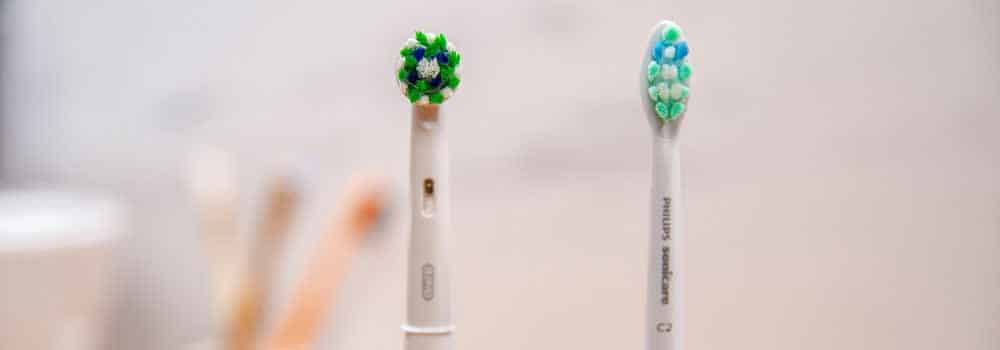
Both the Sonicare 4100 and the Oral-B 1000 have a fairly typical electric toothbrush look to them. The handles are rounded cylinders with the brush head fitting onto a metal shaft that extends from the motor sealed inside the handle.
They are similar in physical size but the 4100 is marginally slimmer. It is too a bit lighter at 1 ounce less than the 1000.
The size and weights of the 2 brushes are as follows:
Pro 1000:
- Height (without head) –7.68 inches/19.5cm
- Height (with head) – 9.13 inches/23.2cm
- Width – 0.98 inches/2.5cm
- Thickness – 1.14 inches/2.9cm
- Weight (without head) – 4.1oz/118g
- Weight (with head) – 4.3oz/123g
4100 Series:
- Height (without head) – 6.8 inches/17.3cm
- Height (with head) – 9.2 inches/23.4cm
- Width – 0.9 inches/2.5cm
- Thickness –1 inches/2.7cm
- Weight (without head) – 3.2oz/92g
- Weight (with head) – 3.4oz/97g
Both have a single power button on the front of the handle. But, the 1000 has a rubber panel around it that provides a color accent to the handle and a gripping surface for the thumb.
The Pro 1000 has either a white, pink, black, or green color to it. All are finished with a gloss coating. The rubber panel around the power button is normally grey in color but is white on the pink variant.
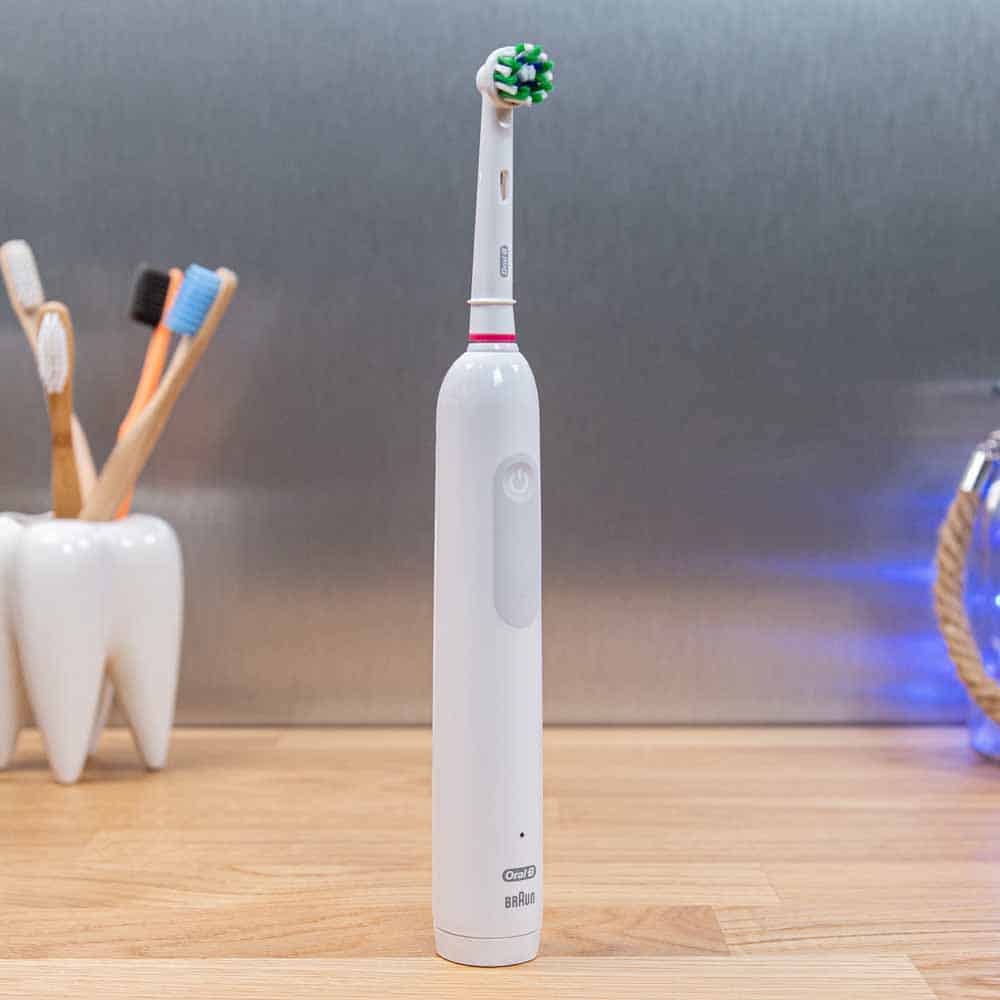
In comparison the 4100 is available in 6 different color options, sugar rose, white, black, deep pink, azure blue and dark forest.
The handle has a matt finish rather than the gloss of the 1000.
Unlike the Pro 1000, the 4100 doesn’t have any grippy materials around the power button, nor does it have the dimpled texture that runs down the back of the Pro 1000’s handle for additional grip.
Personal preference, but I think the matt finish looks more premium.
The 4100 has 1 brushing mode with the option to change between 2 different brushing intensities, high and low.
Arguably the difference in brushing motion between these intensities is equivalent to having different modes.
The high intensity is like the daily clean mode on the Pro 1000, but the low intensity mode is more like the sensitive brushing mode of the Pro 1000.
The 1000 also has a third mode, whitening that the 4100 does not have.
The power of the clean from electric toothbrushes can be off-putting for new users of a power toothbrush.
This is where the EasyStart feature of the 4100 Series really stands out.
Over the first 14 brushing sessions, the power of the brush is increased. It starts off by offering a slightly more gentle experience before gradually increasing the power to the maximum available.
It is a simple and easy tool that eases that transition.
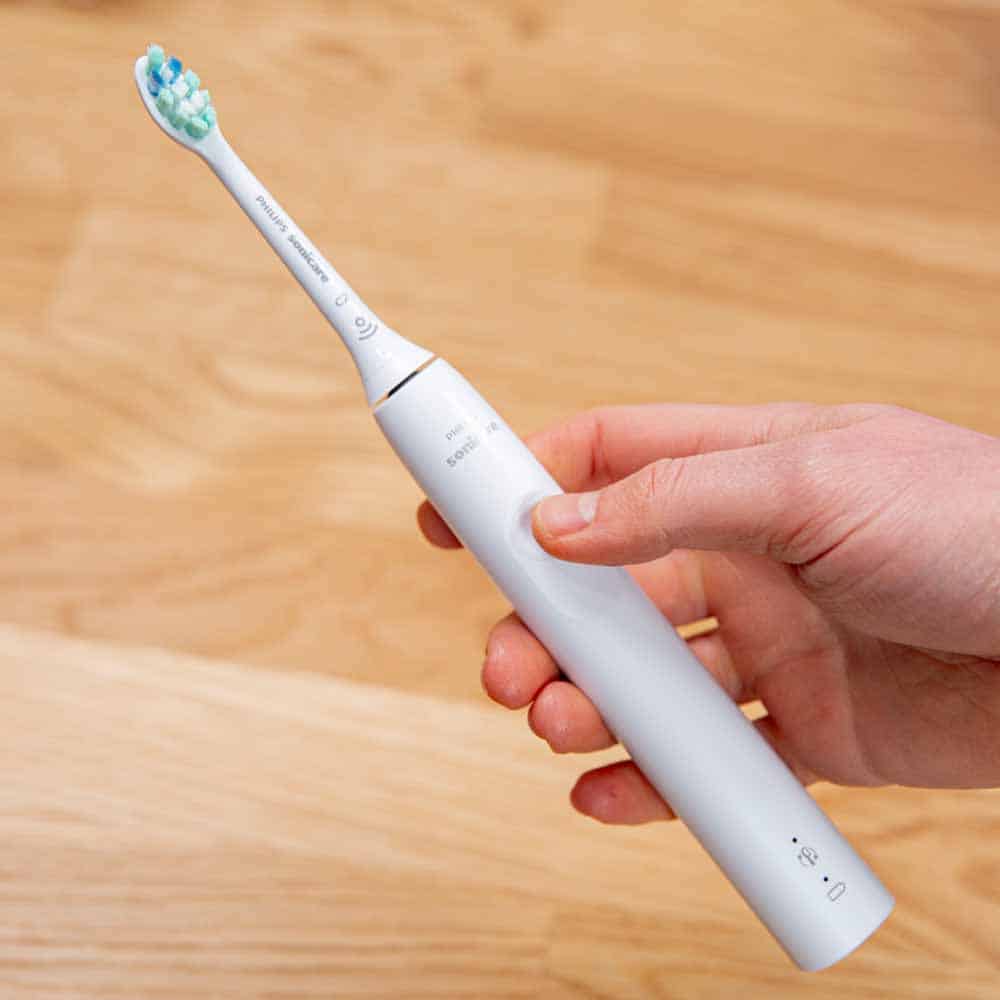
Some manual toothbrush users will scrub the teeth with lots of force, thinking hard and fast scrubbing of the teeth is good. In reality, it isn’t. It can be damaging to the teeth and gums.
Both the 1000 and 4100 have pressure sensors built-in. The implementation of these is different though.
Bristles really only need to skim the tooth surfaces, with just light pressure. If either of these brushes detects excessive force they reduce the number of movements to the bristle tips, until such time as the pressure is relieved.
However, the 4100’s sensor is much more noticeable. The 4100’s handle is vibrated differently when the sensor is activated. The pattern of vibration is very obvious so that you can take immediate corrective action.
You don’t get this on the Pro 1000. It is nigh on impossible to know it has even been triggered.
Some Oral-B models, such as the Smart 1500 have a light that gets lit when activated. The light is usually red and really obvious, but the Pro 1000 doesn’t have this.
The 4100 Series will illuminate the brush head replacement reminder light when the pressure sensor is activated, but the light is far from obvious.
There is additional technology built into the 4100 Series, which is quite clever.
Thanks to a microchip built into the supplied brush head, the handle tracks the usage time of that set of bristles.
Accounting for brushing time and pressure, when the head has passed its recommended usable life (3 months) an LED on the handle is lit orange.
This is the brush head replacement light and it is part of Sonicare’s BrushSync technology.
It is very clever and will help those who forget to replace their bristles at regular intervals.

Failing to do so can result in worse brushing results and the potential for damage to be done to the teeth and gums.
Both Oral-B and Sonicare do have color fading bristles built into their heads that essentially do the same thing but in a less smart fashion.
Neither brush is silent in operation, but it is the Sonicare that is quieter to use. It provides a more audible hum whereas the Oral-B makes a much more mechanical noise. The 4100 produces 60dB compared to the 75dB of the 1000.
A single press of the power button will turn on either of these toothbrushes. As you press the button it will activate the 30 second pacer and 2 minute timer that both models have. These help encourage brushing for the dentist recommended time.
Another subtle difference here though is the automatic power off. Come the end of the 2 minute brushing cycle, the Sonicare turns itself off automatically, whereas the Pro 1000 continues to operate until you turn it off.
You may prefer one over the other, but I think some of these subtle differences actually make the 4100 a more attractive option for everyday use. It feels ever so slightly more refined. Such slight differences only really show their value in repeated daily use.
Sealed inside the handles of these brushes are rechargeable batteries.
The Pro 1000 uses a Nickel Metal Hydride (NiMH) battery compared to the Lithium-Ion (Li-Ion) of the 4100 Series.
Whilst plenty of brushes still use NiMH, most now use Li-Ion as these are often considered better. Li-Ion is the same technology used in smartphone batteries. It isn’t always the case, but usage times tend to be greater.
Oral-B claims the Pro 1000 will last 10 days and I achieved just that, well 10.5 to be precise.
Sonicare claims 14 days, and I achieved 17.
If you use the low intensity setting, the 4100 lasts over 5 weeks, which is much more impressive, but most will want to use the full power of the brush.
In truth, the Oral-B falls a bit short of the 2 week/14 day minimum I expect of a toothbrush today. It might not be a big thing for you, but those who travel frequently might not appreciate the limited usage time from a single charge.
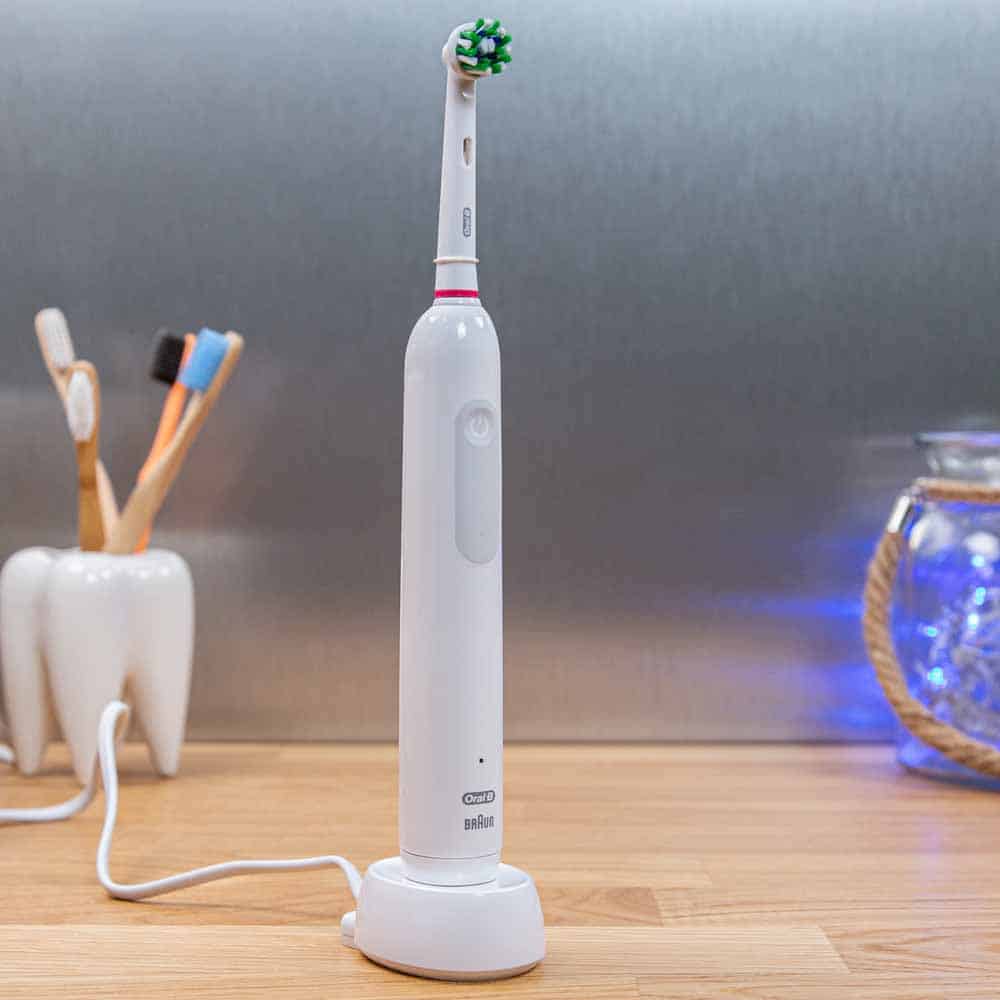
Where the 4100 perhaps takes the edge again is with the feedback you get from the handle about the remaining charge.
Although both have an LED to offer feedback, the 4100 is more comprehensive. The 1000 shows a green light when the battery has a good amount of charge, or red when the power is low.
The LED on the 4100 on the other hand is lit green, yellow or orange subject to the charge status. The handle will vibrate too when the power is really low as another form of notification.
Both brushes come with a charging stand included, but the one supplied with the 4100 supports 100-240v, compared to the 110-130v of the Oral-B stand. It is a small difference, but if you travel frequently it can have an impact.
Also affecting things is the power cable for the stand itself. Both have a power cable hardwired into the stand, but the Sonicare charger has a USB male type A connector compared to the 2 pin US power adapter on the Oral-B charger.
The USB works well for charging from various power sources and can still be powered from a normal outlet, you just need to source or supply your own adapter, you don’t get one in the box.
Does one clean better than the other?
Yes, the clinical evidence would suggest so. Oral-B is generally considered to offer the best cleaning of the teeth and gums.
However, in truth, the difference is very slight.
For most users, it is better to worry about perfecting your brushing routine than it is worrying about which brush you pick.
If you focus more on ensuring you are brushing with the correct technique twice a day for 2 minutes each time, you will likely gain the biggest benefit to your oral health than simply selecting between these 2 toothbrushes.
If you asked the respective brands directly, they would each suggest their model cleans best.
Studies have shown that the rotating-oscillating technology, as used by Oral-B generally speaking, has the edge here.
This is because the smaller brush head size and the motion it has resulted in greater improvements of users oral health than a Sonicare model.
This is however under clinical study conditions and in real-world use, both offer an excellent clean.
I personally prefer the Oral-B cleaning action, but do happily use Sonicare toothbrushes too.
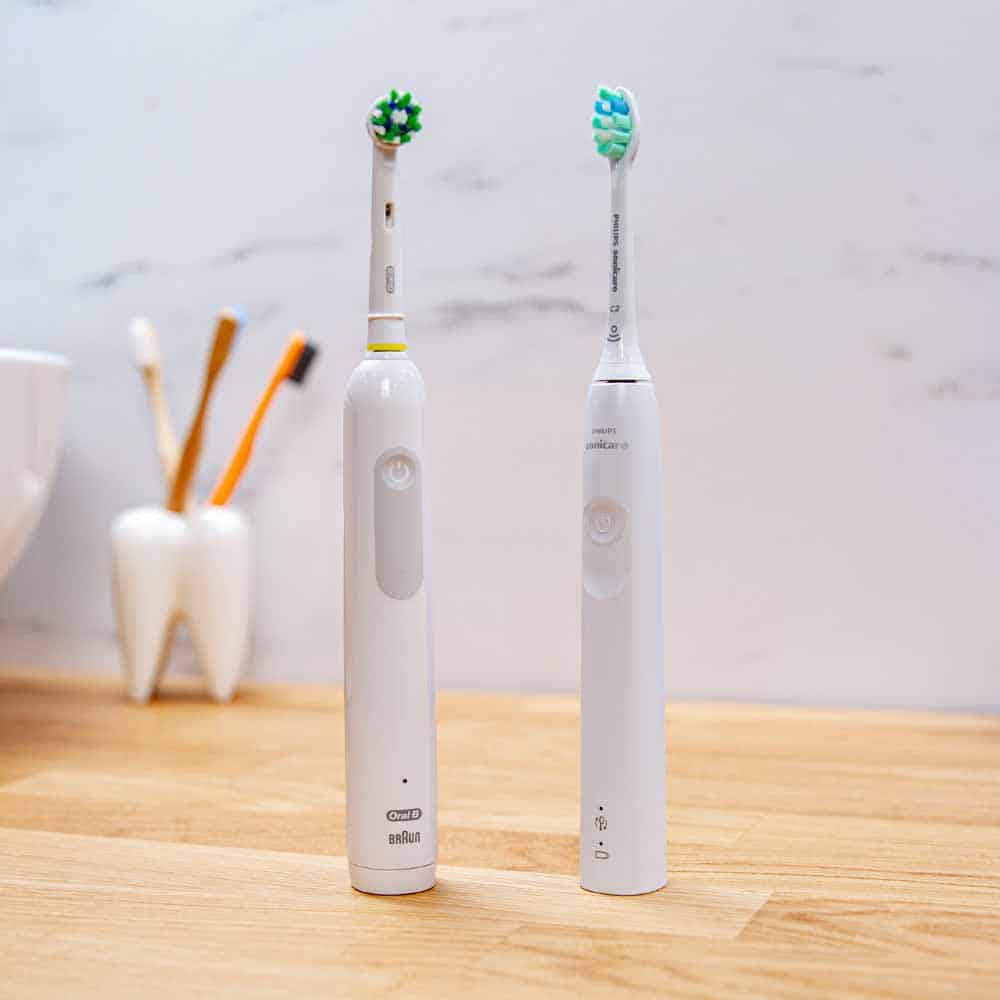
Why I feel this way is because I tend to come away with my teeth feeling cleaner after use. This is likely more a psychological (mental) feeling than reality.
The cleaning action or Oral-B is a bit more of an aggressive clean or so it feels, but the Sonicare is by no means bad. In fact, one of the appeals of Sonicare is how gentle it is. It feels softer on the teeth and gums, but it is still clinically proven as being effective.
Let me be clear, that in daily use the real difference in the cleaning performance is going to be negligible. If one of these is to be your first electric toothbrush, either will offer significant benefits compared to a manual brush.
Is one better priced than the other?
Yes.
Both brushes retail for $50.
It's possible to buy both for less, approximately $40, however, the Pro 1000 is less frequently discounted than the 4100.
In reality, both models are often discounted. The Sonicare tends to be discounted by about 20 percent, with the Oral-B achieving around 35 percent.
Unless you time is when a promotion is running, expect to pay $40 for the Sonicare and $50 for the Oral-B.
Despite the lower retail price, it is actually the Oral-B that works out more cost effective over years of ownership.
This is because of the cost of replacement brush heads.
A single Oral-B head costs approximately $5 compared to $10 for Sonicare.
Part of the reason the 4100 heads are more expensive is as a result of the RFID chip that gets built into the head.
Based on 1 user over a 3 year period, the Oral-B 1000 works out at $105 compared to the $150 of the Sonicare.
That is a fairly reasonable price difference.
It does extend even further if you add another 2 years of ownership cost. You will spend $40 extra on replacement heads for Sonicare than you would with Oral-B.
Over 5 years you could save ~$90 by picking the 1000.
You need to pick the brush that is right for you, but if money is a key consideration, the Oral-B is the more affordable option.
Please note that all prices quoted are approximates and will vary based on location, supplier and time of purchase. These figures were correct at the time of writing and should not be relied upon as hard fact, but used as a guide during your decision process.
Conclusion
I can happily recommend either of these brushes and would use either myself.
Both do a great job of cleaning the teeth and offer the essential features of an electric toothbrush.
Neither are terribly overpriced and bogged down with unnecessary extras.
But, when deciding between them, it is the 4100 Series that takes the edge for me, just.
The pressure sensor implementation, battery life, and choice of brushing intensities make a difference.
|
Our Choice

|
Our Choice

|
|
|---|---|---|
| Electric Teeth Rating |
(4.9)
|
(4.5)
|
| Amazon | $49.49 | $49.94 |
| Philips | View price | - |
| Oral B | - | $49.99 |



